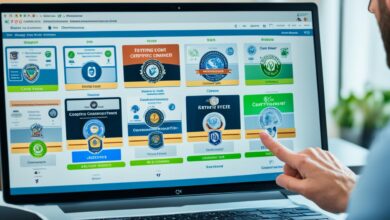Empowering Leadership Strategies for Success

Do you believe that effective leaders are those who wield control and authority?
Or have you ever considered the power of empowering leadership to unlock the full potential of teams and individuals?
In a fast-paced and ever-changing world, what are the strategies that can truly empower leaders to build successful organizations?
In this article, we will explore the concept of empowering leadership and its significance in driving team success, motivation, innovation, and accountability. We will also delve into the characteristics of an empowering leader and the strategies they can implement to create a culture of empowerment. Furthermore, we will discuss the importance of self-assessment as a starting point for empowering leadership and how leaders can synchronize individual aspirations with organizational needs.
Are you ready to discover the power of empowering leadership and uncover strategies to enhance your leadership effectiveness? Let’s dive in!
Key Takeaways:
- Empowering leadership involves believing in the abilities of others and providing them with the necessary tools and autonomy to succeed.
- Empowering leaders foster motivation, accountability, innovation, and trust within teams.
- Characteristics of an empowering leader include empathy, support, continuous learning, effective communication, and adaptability.
- Strategies to become an empowering leader include professional development, communication, autonomy, collaboration, risk-taking, learning mindset, meaningful work, mentorship, and appreciation.
- Self-assessment and synchronizing with organizational needs are crucial steps in the journey towards empowering leadership.
The Importance of Empowering Leadership
Empowering leadership plays a critical role in driving team success. By embracing empowering leadership practices, leaders create a work environment that fosters motivation, accountability, and innovation. Team members thrive when they are empowered, feeling trusted and valued in their contributions. Let’s explore how empowering leadership impacts various aspects of team dynamics:
- Motivation: Empowering team members instills a sense of purpose and drives intrinsic motivation. When individuals feel empowered to make decisions and take ownership of their work, they are more likely to go the extra mile and exceed expectations.
- Accountability: Empowering leadership encourages individuals to take responsibility for their actions. When team members feel empowered, they understand the impact of their work on the overall team success and are motivated to deliver results that meet or exceed expectations.
- Innovation: Empowered employees are more likely to think creatively and explore innovative solutions to challenges. When leaders empower their team members to take risks, share ideas, and experiment, it fosters a culture of innovation and continuous improvement.
- Trust: Trust is the cornerstone of any successful team. Empowering leadership builds trust by demonstrating belief in team members’ abilities and promoting open communication. This trust leads to stronger relationships, improved collaboration, and a shared commitment to team goals.
- Loyalty: Empowering leadership creates a sense of loyalty among team members. When individuals feel valued and supported, they develop a sense of loyalty toward their leaders and the organization. This loyalty drives higher engagement and retention rates, contributing to long-term organizational success.
- Adaptability: In today’s rapidly changing business landscape, adaptability is crucial. Empowering leadership prepares teams to embrace change and adapt quickly to new circumstances. When individuals feel empowered, they are more likely to be open to change and proactively seek innovative solutions to navigate challenges.
Overall, empowering leadership is essential for team success. By empowering team members, leaders create a culture of trust, motivation, accountability, and innovation, setting the stage for remarkable achievements.
Characteristics of an Empowering Leader
An empowering leader embodies a range of qualities that contribute to their effectiveness in fostering growth and success within their team. These characteristics include:
Empathy: Empowering leaders prioritize understanding and recognizing the emotions and experiences of their team members. By empathizing with others, leaders can create a supportive and inclusive environment that allows individuals to thrive.
Support: Emphasizing support, empowering leaders provide the necessary resources, guidance, and encouragement their team members need to excel. They invest time and effort into helping individuals overcome challenges and achieve their goals.
Continuous Learning: Empowering leaders embrace a mindset of continuous learning, seeking out opportunities to develop their own skills and knowledge. This commitment to growth serves as a role model for team members and encourages them to engage in lifelong learning.
Communication Skills: Effective communication is crucial for an empowering leader. They possess excellent listening skills, communicate clearly and transparently, and encourage open dialogue. This fosters trust, collaboration, and constructive feedback within the team.
Optimism: Empowering leaders maintain a positive outlook, even in challenging situations. Their optimism helps inspire hope and resilience within the team, creating an environment where individuals are motivated to overcome obstacles and achieve success.
“An empowering leader is someone who not only demonstrates these characteristics but also encourages them in others, creating a culture of growth and empowerment.”
Adaptability: Empowering leaders are adaptable and flexible in their approach. They embrace change and encourage their team members to do the same. By staying open-minded, they can navigate unexpected circumstances and drive innovation.
Innovation: Empowering leaders foster a culture of innovation by encouraging creativity, experimentation, and risk-taking. They create an environment where new ideas are heard and valued, resulting in breakthroughs and continuous improvement.
Relationship-Building: Empowering leaders prioritize building strong relationships with their team members. They invest time and effort in getting to know each individual, understanding their strengths, aspirations, and needs. These relationships form the foundation for trust, collaboration, and motivation within the team.
By embodying these characteristics, empowering leaders create a supportive and engaging environment that not only empowers individuals but also drives the growth and success of the entire team.
Empowering Leadership Characteristics
| Characteristic | Description |
|---|---|
| Empathy | Prioritizing understanding and recognizing the emotions and experiences of team members |
| Support | Providing necessary resources, guidance, and encouragement for individual growth |
| Continuous Learning | Commitment to ongoing personal and professional development |
| Communication Skills | Effective listening, clear and transparent communication, and open dialogue |
| Optimism | Maintaining a positive outlook, inspiring hope and resilience in others |
| Adaptability | Being flexible and open to change in a dynamic environment |
| Innovation | Encouraging creativity, experimentation, and risk-taking |
| Relationship-Building | Investing in strong relationships to build trust, collaboration, and motivation |
Strategies to Become an Empowering Leader
To become an empowering leader, there are several strategies you can implement within your team. These strategies focus on providing professional development opportunities, encouraging open communication, fostering autonomy, promoting collaboration and teamwork, encouraging risk-taking and experimentation, cultivating a learning mindset, providing meaningful work, offering mentorship and coaching, and showing appreciation for your team members’ contributions and successes.
Firstly, professional development is crucial in empowering your team members. By investing in their growth and providing opportunities for them to enhance their skills and knowledge, you are equipping them to excel in their roles and contribute to the overall success of the team. This can include attending workshops, conferences, or training sessions that align with their professional goals.
Secondly, communication plays a vital role in empowering your team. Encourage open and honest communication by actively listening to your team members, seeking their input, and creating a safe space for them to express their ideas and concerns. Effective communication fosters trust, strengthens relationships, and ensures that everyone is aligned and working towards common goals.
Thirdly, autonomy empowers individuals to take ownership of their work and make decisions independently. By delegating responsibilities and providing the necessary support and resources, you demonstrate trust in your team members’ abilities and encourage them to unleash their creative problem-solving skills. Autonomy sparks innovation and encourages a sense of ownership, resulting in motivated and empowered individuals.
Furthermore, promoting collaboration and teamwork creates an environment where diverse perspectives are valued, and collective efforts drive success. Encourage collaboration by fostering a culture of inclusivity, promoting cross-functional projects, and facilitating opportunities for teamwork. Collaborative environments foster creativity, improve problem-solving abilities, and create a sense of collective ownership and achievement.
Encouraging risk-taking and experimentation is another strategy for empowering leadership. Embrace a culture that encourages calculated risks and rewards innovation. By providing space for experimentation and acknowledging failures as learning opportunities, you create an environment where ideas are freely explored, leading to breakthrough solutions and continuous improvement.
“Taking risks and tolerating mistakes can lead to game-changing innovations and valuable learning experiences.”
Cultivating a learning mindset is essential in empowering leaders. Encourage continuous learning and personal growth by creating opportunities for skill development, providing access to resources and educational platforms, and supporting ongoing professional development. A learning mindset promotes adaptability, resilience, and a hunger for knowledge, empowering individuals to thrive in a rapidly changing business landscape.
Providing meaningful work is a powerful strategy in empowering your team members. Ensure that the tasks and projects assigned to each individual align with their skills, interests, and aspirations. Meaningful work enhances motivation, engagement, and job satisfaction, resulting in higher quality output and a sense of fulfillment.
Offering mentorship and coaching is another effective strategy for developing empowering leaders. As a leader, you can impart your knowledge and expertise to your team members through regular mentorship sessions. This helps individuals develop their skills, overcome challenges, and foster personal growth. Furthermore, coaching enhances performance, builds resilience, and empowers individuals to reach their full potential.
Show appreciation for your team members’ contributions and successes. Recognize their efforts and achievements, both privately and publicly. This fosters a sense of pride, motivation, and loyalty among team members, while also promoting a positive and encouraging work environment.
Implementing these strategies will help you become an empowering leader who fosters growth, collaboration, and innovation within your team. By empowering your team members, you create a supportive environment that drives their personal and professional development, resulting in enhanced individual and team performance.
Empowering Leadership Strategies
| Strategies | Benefits |
|---|---|
| Provide professional development opportunities | Enhanced skills and knowledge, improved performance |
| Encourage open communication | Stronger relationships, increased trust, aligned goals |
| Foster autonomy | Ownership, creativity, innovation |
| Promote collaboration and teamwork | Diverse perspectives, collective success |
| Encourage risk-taking and experimentation | Innovation, problem-solving, continuous improvement |
| Cultivate a learning mindset | Adaptability, resilience, personal growth |
| Provide meaningful work | Motivation, engagement, job satisfaction |
| Offer mentorship and coaching | Skills development, personal growth, enhanced performance |
| Show appreciation | Motivation, loyalty, positive work environment |
Starting with Self-Assessment
The journey towards empowering leadership begins with self-assessment. It is important to encourage team members to evaluate their passions, skills, and career aspirations in order to align their personal goals with the objectives of the organization. Self-assessment serves as the foundation for creating a professional development plan that supports individual growth and contributes to the overall success of the team.
By engaging in self-assessment, individuals gain a deeper understanding of their strengths, weaknesses, and areas for improvement. This process allows them to identify their unique talents and interests, which can then be leveraged to enhance their effectiveness as leaders.
Self-assessment also plays a critical role in helping individuals align their career aspirations with the opportunities available within the organization. By evaluating their skills and identifying areas for growth, individuals can create a roadmap for professional development that ensures their goals are in line with the strategic direction of the company.
Moreover, self-assessment encourages individuals to reflect on their values, motivations, and passions. This introspection helps them align their personal values with the values of the organization, fostering a sense of purpose and fulfillment in their work.
“Self-assessment is not just about understanding one’s skills and abilities; it is about gaining insight into one’s passions, aspirations, and values. This knowledge serves as a compass for developing as an empowering leader.” – Emily Roberts, HR Consultant
Through self-assessment, individuals gain clarity on their unique strengths and how they can contribute to the success of the team. It enables them to identify areas where additional training or development may be beneficial, allowing them to take proactive steps towards their professional growth.
Harnessing passion and skills
Self-assessment also helps individuals recognize their passions and align them with their work. When individuals are passionate about what they do, their motivation and engagement levels increase, leading to higher levels of productivity and job satisfaction.
Additionally, self-assessment empowers individuals to identify and leverage their existing skills and competencies. By recognizing their strengths, individuals can focus on further developing and applying those skills in their leadership roles.
Ultimately, by starting with self-assessment, individuals lay the groundwork for their journey towards becoming empowering leaders. It is a vital step that enables them to gain clarity on their passions, skills, and career aspirations, creating a strong foundation for their professional development and success.
| Benefits of Self-Assessment for Empowering Leadership |
|---|
| Helps individuals align personal goals with organizational objectives |
| Identifies strengths, weaknesses, and areas for improvement |
| Aligns career aspirations with organizational opportunities |
| Fosters a sense of purpose and fulfillment in work |
| Increases motivation and engagement levels |
| Enables individuals to leverage existing skills and competencies |
Managerial Insight
As leaders, it is essential to provide valuable managerial insight to support the growth and development of our team members. Managerial insight involves assessing their self-evaluations and determining their skill levels, potential, and areas for growth. This not only helps us understand their current capabilities but also enables us to identify opportunities for improvement and advancement.
Managerial insight is not about passing judgment; rather, it is about gaining a deeper understanding of our team members’ strengths, weaknesses, and aspirations. By investing time and effort in assessing their skill level and potential, we can provide targeted guidance and support to help them achieve their professional goals.
When it comes to managerial insight, effective communication is key. Engaging in open and honest conversations with our team members allows us to share our observations, provide constructive feedback, and offer guidance for their ongoing development. This collaborative approach fosters trust and creates a supportive environment where individuals can thrive and reach their full potential.
“Managerial insight plays a critical role in empowering team members. When leaders invest the time to understand their skill levels and potential, they can provide the necessary support and opportunities for growth.”
Furthermore, leveraging our managerial insight, we can identify specific areas where our team members can benefit from targeted professional development programs, training, or mentorship opportunities. By tailoring our guidance and development initiatives to their individual needs, we can maximize their potential and contribute to their long-term success.
Example of Managerial Insight in Action
Let’s consider a scenario where a team member expresses interest in taking on more responsibilities and advancing in their career. As a leader, utilizing our managerial insight, we can assess their skill level and potential through performance evaluations, assessment tools, and discussions with their peers and colleagues.
Based on our assessment, we might identify areas where they have demonstrated exceptional skills, such as problem-solving or communication, and highlight these strengths, encouraging them to continue developing these abilities. Simultaneously, we may identify areas where they can further enhance their expertise, such as project management or leadership skills, and provide them with targeted learning opportunities or mentorship.
By sharing our managerial insight and facilitating their professional growth, we empower our team members to take ownership of their development and pursue career advancement opportunities. Ultimately, this approach benefits both the individual and the organization, fostering a culture of continuous learning and high performance.
Synchronizing with Organizational Needs
When developing professional growth plans, it is essential to synchronize them with both an individual’s career path and the strategic requirements of the organization. By aligning personal ambitions with the company’s objectives, employees can contribute to the organization’s growth while advancing in their careers.
Understanding and addressing the organizational needs helps individuals determine the skills and knowledge they need to develop to meet strategic requirements. It allows employees to identify the areas in which they can make a significant impact and contribute to the overall success of the organization.
Aligning Career Paths
Aligning professional growth plans with career paths ensures that employees receive development opportunities that are mutually beneficial for them and the organization. By identifying the skills, competencies, and experiences required for progression along their chosen career paths, individuals can focus their development efforts on acquiring the necessary capabilities.
Considering career paths also facilitates succession planning and talent management within the organization. It enables leaders to identify potential high-performing employees who can be groomed for more significant responsibilities and leadership positions in the future.
Meeting Strategic Requirements
Strategic requirements vary across organizations and industries. They encompass the goals, objectives, and priorities that drive an organization’s success. Developing professional growth plans that align with strategic requirements ensures that employees are equipped with the skills and knowledge to address current and future challenges.
By synchronizing professional development with strategic requirements, organizations can foster a culture of continuous improvement and innovation. Employees become better equipped to handle changing market dynamics, evolving customer needs, and emerging industry trends, positioning the organization for long-term success.
Effective professional development plans are like compasses that guide individuals toward their career goals while supporting the strategic needs of the organization.
To illustrate the importance of synchronizing with organizational needs, the table below highlights examples of how different career paths align with specific strategic requirements:
Conclusion
Synchronizing professional growth plans with organizational needs and career paths is essential for fostering sustainable individual development and contributing to the strategic success of the organization. By aligning personal ambitions with strategic requirements, employees can enhance their skills, knowledge, and capabilities, ensuring their growth aligns with the evolving needs of the organization.
Exploring Development Opportunities
A vital aspect of empowering leadership is identifying and exploring growth opportunities for team members. By providing access to an internal Development Academy, encouraging participation in innovative projects, and facilitating attendance at valuable workshops and seminars, leaders can cultivate an environment that fosters continuous learning and personal development.
“Investing in the growth and upskilling of employees not only enhances their capabilities but also boosts their motivation and engagement. It is a win-win situation for both individuals and the organization.”
The internal Development Academy serves as a valuable resource where employees can refine their skills, acquire new knowledge, and enhance their expertise. Through a series of targeted programs, workshops, and training sessions, individuals have the opportunity to expand their skill sets and explore new areas of interest. This initiative promotes a culture of lifelong learning and empowers individuals to take charge of their professional growth.
In addition to the internal Development Academy, empowering leaders encourage their team members to actively participate in innovative projects. These projects provide an opportunity to explore new concepts, experiment with novel approaches, and collaborate with colleagues from different departments. Engaging in innovative projects not only enhances individual skill sets but also fosters a culture of creativity and innovation within the organization.
Workshops and seminars are another avenue for development that empowering leaders leverage. By attending relevant workshops, employees gain access to expert knowledge, industry trends, and best practices. These learning opportunities foster personal growth and keep individuals abreast of the latest advancements and techniques in their respective fields.
Benefits of Exploring Development Opportunities
Exploring development opportunities offers several benefits to both individuals and the organization:
- Professional Growth: Participation in development programs, projects, and workshops enables individuals to expand their skills, knowledge, and expertise, promoting their professional growth.
- Innovation: By engaging in innovative projects and attending relevant seminars, employees gain exposure to new ideas and approaches, fostering a culture of innovation within the organization.
- Engagement and Motivation: Providing growth opportunities demonstrates a commitment to employee development, leading to increased engagement, motivation, and job satisfaction.
- Talent Retention: Empowering leaders who invest in their team members’ growth and development are more likely to attract and retain top talent, creating a competitive advantage for the organization.
Empowering leaders recognize the value of exploring development opportunities and actively support their team members in pursuing continuous growth. By leveraging internal resources, engaging in innovative projects, and attending relevant workshops, individuals can enhance their skill sets, maximize their potential, and contribute to the overall success of the organization.
Monitoring and Feedback
As an empowering leader, it is crucial to consistently monitor and track the progress of your team members. Progress tracking allows you to stay informed about individual and collective achievements, identify areas for improvement, and ensure that everyone is on track to meet their goals. By actively monitoring progress, you can provide timely and constructive feedback that facilitates growth and development.
Regularly engaging in an ongoing dialogue with your team members is key to maintaining open lines of communication. This dialogue serves as a platform for sharing insights, addressing concerns, and fostering a collaborative environment. Encourage your team members to share their thoughts, ideas, and challenges, as this ongoing dialogue enables you to gain valuable insights into their experiences and perspectives.
“Constructive feedback is instrumental in empowering your team members to enhance their performance and achieve their full potential.”
Constructive feedback is instrumental in empowering your team members to enhance their performance and achieve their full potential. By providing feedback that is specific, actionable, and focused on growth, you can guide individuals towards greater success. Acknowledge their accomplishments and strengths, while also offering guidance on areas that require improvement in a supportive and constructive manner.
Recognizing Accomplishments
Recognizing and celebrating individual and team achievements is an essential part of the feedback process. Positive reinforcement not only boosts morale but also reinforces the value of hard work and dedication. Take the time to acknowledge and appreciate the progress made by your team members, both big and small. This recognition helps to foster a positive and motivating work environment.
Identifying Areas for Improvement
While recognizing accomplishments is important, it is equally crucial to identify areas where further development and improvement are needed. Through progress tracking and ongoing dialogue, you can pinpoint specific areas that require attention and provide targeted guidance for growth. By addressing these areas constructively, you empower your team members to make meaningful progress and reach their full potential.
Supporting Learning Moments
View feedback as an opportunity to support learning moments within your team. Encourage your team members to embrace challenges and take calculated risks, recognizing that mistakes and setbacks are valuable learning experiences. Foster a culture of continuous learning and improvement, where feedback serves as a catalyst for personal and professional growth.
Remember, effective monitoring and feedback are ongoing processes that require commitment and effort. By consistently tracking progress, providing constructive feedback, and maintaining an ongoing dialogue, you can foster an environment of empowerment and growth within your team.
For more information on the importance of feedback in improving performance, visit here.
Conclusion
Empowering leadership plays a crucial role in promoting both individual professional growth and organizational success. By implementing strategies such as providing professional development opportunities, fostering open communication, and encouraging collaboration and autonomy, leaders can create a culture of empowerment and continuous improvement. This enables individuals to enhance their skills and contribute to the overall skill set of the organization.
Research has shown that empowering leadership positively impacts employee motivation and innovation, leading to improved organizational performance and success. Through professional growth and development, individuals gain confidence and accountability, enabling them to take on new challenges and adapt to changing environments.
Organizations that prioritize empowering leadership foster an environment where employees feel valued, supported, and motivated to achieve their full potential. By aligning personal aspirations with organizational objectives, leaders can create a win-win situation that not only benefits individuals but also contributes to the overall success of the organization.
As we strive for continuous improvement and growth, embracing empowering leadership becomes imperative. By investing in the development of leaders and providing opportunities for professional growth, organizations can cultivate a workforce that is equipped with the skills, motivation, and empowerment needed to thrive and succeed in today’s competitive landscape.







